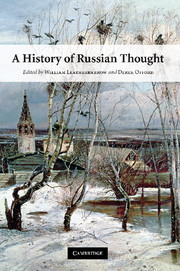Book contents
- Frontmatter
- Contents
- Preface
- List of contributors
- Dates, transliteration and other conventions
- Dates of reigns
- Russian titles of journals, newspapers and miscellanies
- PART I CONTEXT
- PART II INTELLECTUAL CURRENTS
- 4 Russia's eighteenth-century Enlightenment
- 5 Conservatism in the age of Alexander I and Nicholas I
- 6 Nihilism
- 7 Tradition and counter-tradition: the radical intelligentsia and classical Russian literature
- 8 Religious renaissance in the Silver Age
- PART III THEMES AND CONSTRUCTS
- PART IV THE AFTERLIFE OF CLASSICAL THOUGHT
- Biographical details of thinkers and writers
- Selected bibliography
- Index
8 - Religious renaissance in the Silver Age
Published online by Cambridge University Press: 05 June 2012
- Frontmatter
- Contents
- Preface
- List of contributors
- Dates, transliteration and other conventions
- Dates of reigns
- Russian titles of journals, newspapers and miscellanies
- PART I CONTEXT
- PART II INTELLECTUAL CURRENTS
- 4 Russia's eighteenth-century Enlightenment
- 5 Conservatism in the age of Alexander I and Nicholas I
- 6 Nihilism
- 7 Tradition and counter-tradition: the radical intelligentsia and classical Russian literature
- 8 Religious renaissance in the Silver Age
- PART III THEMES AND CONSTRUCTS
- PART IV THE AFTERLIFE OF CLASSICAL THOUGHT
- Biographical details of thinkers and writers
- Selected bibliography
- Index
Summary
I am not sure who coined the phrase ‘Russian religious renaissance’. Perhaps it was Nicolas Zernov, whose survey of the phenomenon is entitled The Russian Religious Renaissance of the Twentieth Century, or perhaps he took over the term from one of its participants. For Zernov, the term ‘religious renaissance’ denotes the rebirth among the Russian intelligentsia of interest and participation in the Christian religion where these had been dead. If there is an allusion to the western European Renaissance at the beginning of the modern period, then this is an indication that the Russian religious renaissance took place on a high cultural level, that the return to faith incorporated a flowering of philosophy and the arts. However, this was more than a simple return to Russian Orthodoxy. Another intellectual historian of the Silver Age, Piama Gaidenko, also frequently likens the period to the European Renaissance, but in a negative sense (from her perspective), on account of its recourse to pagan culture and the aggressive humanism of many of its leading representatives. And indeed, the Russian religious renaissance had, broadly speaking, two faces. When one looks at one set of texts it appears to represent a straightforward reversal of the ideological shift from theism to humanism that took place at the close of the Middle Ages, whereas another set indicates a more ambiguous (and ambivalent) religious awareness that sets itself in direct opposition to traditional Christianity and the church.
- Type
- Chapter
- Information
- A History of Russian Thought , pp. 169 - 194Publisher: Cambridge University PressPrint publication year: 2010
- 3
- Cited by



